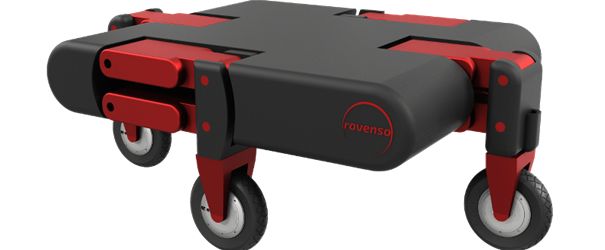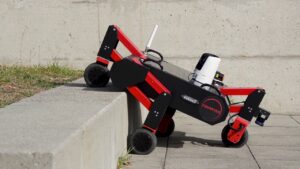
ROVéo, A Swiss Robot that Kills the Coronavirus
A company in Fribourg, Switzerland has created a robot that moves around autonomously, even going up and down stairs. Originally designed to conduct security checks in enterprises at night and to patrol industrial sites, ROVéo the robot has been equipped with an additional module that allows it to eliminate viruses and microorganisms on door handles and other contaminated surfaces using ultraviolet radiation.
ROVéo is a small vehicle about 50 cm (20 inches) tall and 1 meter (39 inches) long, with four powered wheels. It looks a bit like the Mars exploration rovers. The robot has many sensors that allows it to understand its environment, and five near-infrared cameras that provide a visibility range that cannot be perceived with the human eye. It also has three thermal cameras to measure the temperature, microphones to spot where a sound is coming from and two Vidar lasers to measure the distance of the objects around it. These elements allow the robot to construct an extremely precise 3D map of its surroundings.
ROVéo was conceived to monitor safety and security conditions in industrial sites. The robot is usually used at night to detect intruders, smoke and fires, water damage or even gas pipe defects or damage.
When the robot detects a problem, it calls a security alarm center and displays on a screen exactly where it is located. These images allow the surveillance people in the center to see the problem on-site.
The Swiss company Rovenso has transformed ROVéo during its night patrols into a coronavirus killer. Its creators equipped it with short-wavelength UVC, the most damaging type of ultraviolet radiation. These rays have germicidal effects, meaning they destroy harmful microorganisms, such as bacteria, protozoa and, importantly, coronaviruses like the one that causes COVID-19. UVC breaks up the genetic material of pathogens floating in air or water and sticking to surfaces. These rays are thus used as disinfectants.
ROVéo was equipped with what looks like a desk lamp, which was attached to the robot. The lamp directs its specific UVC neon lighting towards surfaces at a distance of 50 cm (20 inches). This lighting is already used in unoccupied hospital rooms or to disinfect medical tools like stethoscopes.
In industrial settings, where the spaces are large, the robot models its environment in 3D and identifies the areas that need to be treated, the surfaces touched by humans. Examples include meeting and cafeteria tables, workbenches and snack dispensers. The robot then calculates the UVC dose needed to disinfect the surface. The light will destroy 99% of the pathogens on a surface in 10-15 seconds.
UVC light is very dangerous for humans, however. Exposure to it causes serious burns and eye damage within seconds. Conventional UVC light sources are both carcinogenic and cataractogenic, so capable of causing cancer and inducing the formation of cataracts.
Nevertheless, a 2018 article published in February 2018 in the journal Nature shows research into “far-UVC light (207–222 nm) [that] efficiently inactivates bacteria without harm to exposed mammalian skin. This is because, due to its strong absorbance in biological materials, far-UVC light cannot penetrate even the outer (non living) layers of human skin or eye; however, because bacteria and viruses are of micrometer or smaller dimensions, far-UVC can penetrate and inactivate them.” The authors “show for the first time that far-UVC efficiently inactivates airborne aerosolized viruses, with a very low dose of 2mJ/cm2 of 222-nm light inactivating >95% of aerosolized H1N1 influenza virus.”
The researchers at the Columbia University Medical Center in New York thus conclude that “Continuous very low dose-rate far-UVC light in indoor public locations is a promising, safe and inexpensive tool to reduce the spread of airborne-mediated microbial diseases.”
Meanwhile, ROVéo, with its special UVC light, is still being tested. If demand is strong, Rovenso may manufacture the robot for wide distribution on the open market. Originally, the company created it to protect its own workers from coronavirus infection.


